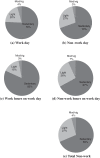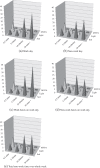The contribution of office work to sedentary behaviour associated risk
- PMID: 23557495
- PMCID: PMC3651291
- DOI: 10.1186/1471-2458-13-296
The contribution of office work to sedentary behaviour associated risk
Abstract
Background: Sedentary time has been found to be independently associated with poor health and mortality. Further, a greater proportion of the workforce is now employed in low activity occupations such as office work. To date, there is no research that specifically examines the contribution of sedentary work to overall sedentary exposure and thus risk. The purpose of the study was to determine the total exposure and exposure pattern for sedentary time, light activity and moderate/vigorous physical activity (MVPA) of office workers during work and non-work time.
Methods: 50 office workers from Perth, Australia wore an Actical (Phillips, Respironics) accelerometer during waking hours for 7 days (in 2008-2009). Participants recorded wear time, waking hours, work hours and daily activities in an activity diary. Time in activity levels (as percentage of wear time) during work and non-work time were analysed using paired t-tests and Pearson's correlations.
Results: Sedentary time accounted for 81.8% of work hours (light activity 15.3% and MVPA 2.9%), which was significantly greater than sedentary time during non-work time (68.9% p < 0.001). Office workers experienced significantly more sustained sedentary time (bouts >30 minutes) and significantly less brief duration (0-10 minutes) light intensity activity during work hours compared to non-work time (p < 0.001). Further, office workers had fewer breaks in sedentary time during work hours compared to non-work time (p < 0.001).
Conclusions: Office work is characterised by sustained sedentary time and contributes significantly to overall sedentary exposure of office workers.
Figures


References
-
- Bauman A, Ainsworth BE, Sallis JF, Hagstromer M, Craig CL, Bull FC, Pratt M, Venugopal K, Chau J, Sjostrom M. The descriptive epidemiology of sitting - a 20 country comparison using the International Physical Activity Questionnaire (IPAQ) Am J Prev Med. 2011;41:228–235. doi: 10.1016/j.amepre.2011.05.003. - DOI - PubMed
-
- Healy GN, Wijndaele K, Dunstan DW, Shaw JE, Salmon J, Zimmet PZ, Owen N. Objectively measured sedentary time, physical activity, and metabolic risk. Diab Care. 2008;31(2):369–371. - PubMed
Publication types
MeSH terms
LinkOut - more resources
Full Text Sources
Other Literature Sources
Medical

